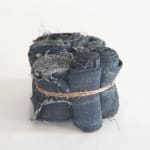


artisan's name unknown
Tatami Edges
Bundle of rolled edges from tatami mats
6'' w x 3 1/2'' h
Sold
Further images
Some objects contain a charisma that is undeniable, no matter what their function or lack thereof may be. This bundle of the discarded ends of tatami mats is exactly that....
Some objects contain a charisma that is undeniable, no matter what their function or lack thereof may be. This bundle of the discarded ends of tatami mats is exactly that. The object has a strange double presence that is at once recognizable yet abstract and expressive. For even if we don’t know exactly what its origins are, we cannot doubt that this is a bundle fashioned with twine from various rolls of indigo fabric. And yet some magic of time and use has given each roll its own personality, its own line and gesture as if they each came from the hand of a different artist. Some have composed, neat ends, while others crackle and fray with anarchic joy. A few have retained their deep indigo color, while others reveal hints of un-dyed cotton through unfurling ends and areas of wear. Either way, this motley crew of characters is inextricably intertwined, bunched together at the middle in chaotic unison.
Indigo dyed cotton is no longer used to line the ends of tatami mats; this object is consequently the result of a long outdated process. The indigo ends were likely eroded by the many feet that passed over them, until they were no longer seen as fit to decorate anyone’s interior. While the worn out tatami were tossed out, it must have crossed one tatami maker's mind to hang on to these indigo edges. One must wonder who this person must have been, and what potential for beauty he saw in the pieces that caught his eye. Whoever he is, and whatever he may have seen at the time, we owe him thanks.
This object could only be what it is because it was transformed by use. It reckons to the contemporary practice of documenting performance art, as it functions like a remnant of the weight of many feet that have passed over it and altered its form. The “art” of the piece exists in its material form, but also of the process that it documents.
Indigo dyed cotton is no longer used to line the ends of tatami mats; this object is consequently the result of a long outdated process. The indigo ends were likely eroded by the many feet that passed over them, until they were no longer seen as fit to decorate anyone’s interior. While the worn out tatami were tossed out, it must have crossed one tatami maker's mind to hang on to these indigo edges. One must wonder who this person must have been, and what potential for beauty he saw in the pieces that caught his eye. Whoever he is, and whatever he may have seen at the time, we owe him thanks.
This object could only be what it is because it was transformed by use. It reckons to the contemporary practice of documenting performance art, as it functions like a remnant of the weight of many feet that have passed over it and altered its form. The “art” of the piece exists in its material form, but also of the process that it documents.
16
of
16
Signup for our Newsletter
You will receive two emails a month from us. One introduces artworks and design works from Kyoto's hidden sources and the other is stories from Misako, sharing insights into Japanese culture.
* denotes required fields
为了回应您的查询,我们将根据我们的隐私政策处理您提供的个人数据。


